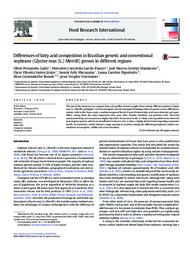Differences of fatty acid composition in brazilian genetic and conventional soybeans (Glycine max (L.) Merrill) grown in different regions.
Differences of fatty acid composition in brazilian genetic and conventional soybeans (Glycine max (L.) Merrill) grown in different regions.
Author(s): GALÃO, O. F.; CARRÃO-PANIZZI, M. C.; MANDARINO, J. M. G.; SANTOS JÚNIOR, O. O.; MARUYAMA, S. A.; FIGUEIREDO, L. C.; BONAFE, E. G.; VISENTAINER, J. V.
Summary: The aim of this study was to compare fatty acid profiles of seed samples from twenty different soybean (Glycine max (L.) Merrill) genotypes (14 non-transgenic and six transgenic Roundup-tolerant) grown at two different locations, both in the Parana state, a southern region of Brazil. A total of eleven fatty acids were detected and quantified, among them the most expressive ones were oleic, linoleic, linolenic and palmitic acids. The total unsaturated fatty acid amount was higher than 82%. An increase in the n-3 fatty acids quantities were observed in transgenic species, which can be reflected in lower n-6/n-3 ratios, a highly desired trend regarding consumers' health. In conclusion, results showed a large amount of variation among the different germplasms (either conventional or transgenic) within and across locations.
Publication year: 2014
Types of publication: Journal article
Unit: Embrapa Wheat
Keywords: Soja, Soybean, Ácido Graxo
Observation
Some of Embrapa's publications are published as ePub files. To read them, use or download one of the following free software options to your computer or mobile device. Android: Google Play Books; IOS: iBooks; Windows and Linux: Calibre.
Access other publications
Access the Agricultural Research Database (BDPA) to consult Embrapa's full library collection and records.
Visit Embrapa Bookstore to purchase books and other publications sold by Embrapa.

